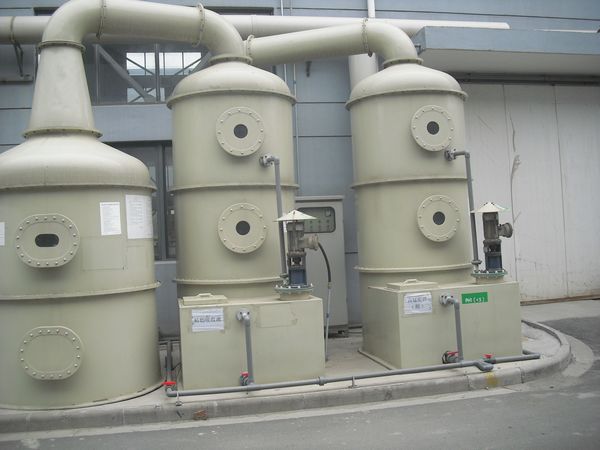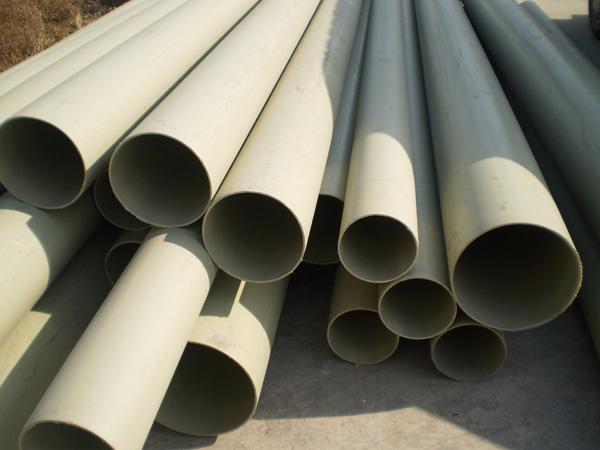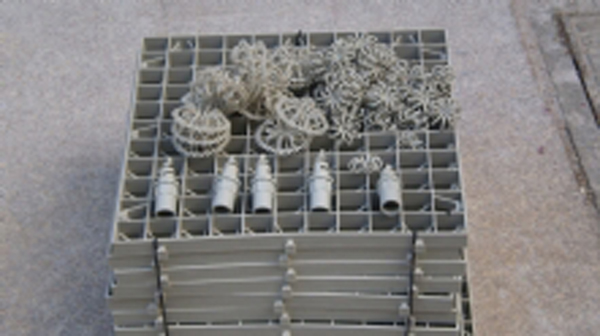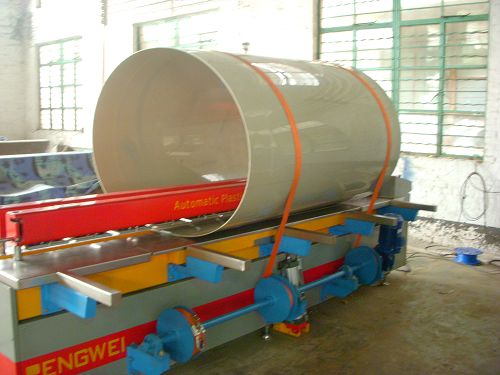注意事项?
设备左侧为进风口方向,废气的温度控制在60°C以下左右。因为温度太高会影响净化效果和设备使用寿命。
净化器安装在风机前面,?净化器前端应该有水喷淋降解有机废气中的大型颗粒,以保证净化器内部洁净度和使用年限和延长维护时间。
净化器如安装在支架之上时,应与支架紧固连接;净化器与排风管道之间的连接必须密封;?
净化器可以安装在室内,也可安装在室外,但应有足够的空间用来维护与维修;
根据使用情况设备定期维护清洗。?
净化器箱体应可靠接地;
安装过程中不允许磕碰紫外线管,严禁***落在净化器内;?净化器本体及电控箱中各电器连接应可靠无误。
设备外接电源380V,因设备内有***紫外线,检修时要佩戴深色墨镜以免伤害眼睛
一种工业光氧催化除臭净化设备,它涉及一种废气的光化学方法净化装置。本实用新型是要解决现有设备除臭净化效率低、紫外线灯管寿命短的技术问题。本实用新型的设备,它包括气体均布网、气液分离器、光氧催化装置和阻风板;所述的光氧催化装置又包括箱体、紫外线灯管和缓冲板,所述的箱体内部平行安装有多组紫外线灯管和缓冲板,所述缓冲板包括多个表面涂有二氧化钛的Z字型板材,板材互相交错叠加,之间有间隙。本实用新型的设备对污染物降解速度快、能耗低、应用范围广,还可延长紫外线灯管寿命。
光催化是指在光的作用下进行的化学反应。光化学反应需要分子吸收特定波长的电磁辐射,受激产生分子激发态,继而发生化学反应生成新的物质或变成引发热反应的中间化学产物。光催化剂是指在光的照射下,自身不起变化,却可以促进化学反应的物质。它利用光能转化成化学反应所需的能量,产生催化作用,使周围的氧气及水分子激发成***氧化力的自由基或负离子。
光催化氧化分为均相光催化氧化和非均相光催化氧化。均相光催化氧化主要为UV***法。废气处理设备的工作原理:
是将气体中的污染物质分离出来,转化为无害物质,以达到净化气体的目的。它属于微分接触逆流式,塔体内的填料(拉西环)是气液两相接触的基本构件。它能提供足够大的表面积,使气液流动又不致造成过大的阻力。废气由风管吸入,自下而上穿过填料层,循环吸收剂由塔顶通过液体分布器,均匀地喷淋到填料层中,沿着填料层表面向下流动,进入循环水箱。由于上升气流和下降吸收剂在填料中不断接触,上升气流中流质的浓度愈来愈低,到塔顶时达到排放要求。
废气处理设备技术参数:
风量:10-1250CMM(立方米/分钟)
静压:60-220mmAQ(毫米水柱压力)
净化塔:Φ600-Φ4200mm(根据需要抽风量选配) 过滤方式:逆水洗中和过滤.
风机功率:1HP-100HP(根据需要抽风量选配).
泵浦功率:1HP-10HP(根据净化塔大小选配).
自动加药系统:PH值0-14(根据废气性质可选择)
外型尺寸:立式、卧式、圆型、方型(根据场地设计)
材质:工程级PP、PVC、FRP、SS41、SUS304、SUS316材料(根据废气性质与客户要求)
净化效率高:新型酸碱废气净化塔采用2-3级逆向喷淋,特殊填料比表面积非常大,除雾层增加抗湿阻水及再次吸收废气做用。试验研究确定的气液比并保证了性能稳定性,对各种浓度的酸性废气(除外)及碱性废气净化效率均可达到85%~95%。占地面积小:酸雾净化塔将塔体、吸收液槽、循环泵、吸收液管道系统组合成一套完整的设备,结构紧凑,便于现场安装及操作管理,占地面积小,无论对新建工程还是技改项目都可适应。
适用范围:
酸性气体:***,盐酸,,氢***,亚***,碳酸,磷酸,冰醋酸,羧酸等;
碱性气体:***,***,氨气,氢氧化铜,氢氧化镁,氢氧化亚铁,氢氧化铁,氢氧化铝,氢氧化钙等;
盐类气体:***,氯化钠,氯化铜,氯化镁,氯化钙,氯化锌,***,氯化铁,氯化铝,***,***等
氧化物气体:***,二氧化碳,***,***,***,***,一氧化氮,氧化钠,氧化钾,氧化银,,氧化铜,氧化镁,氧化钙,氧化锌,氧化亚铁,氧化铁,氧化铝,二氧化钛,二氧化锰,四氧化三铁等
有机气体:苯类,醇类,酚类等。治理不同的***气体采用不同的吸收液。如需详细了解敬请致电
当有光辐射(如紫外光)时,Fenton***氧化性显著提高。UV/Fenton法也叫光助Fenton法,是普通Fenton法与UV/H2O2两种系统的复合产物,降低Fe2+用量的同时保持H2O2较高的利用率,而UV和Fe2+对H2O2的催化分解存在协同效应,˙OH的生成速率远大于传统Fenton法和紫外催化分解H2O2速率的简单加和。因此UV/Fenton***法在处理难降解有机污染物时具有独特的优势,很有应用前景。
非均相光催化氧化技术主要为TiO2光催化氧化技术。自从日本学者Fujishima和Honda于1972年在半导体TiO2电极上发现了水的光催化分解作用,开辟了半导体光催化这一新领域。1977年,Yokota等发现TiO2在光照条件下对丙烯环氧化具有光催化活性,从而拓宽了光催化的应用范围,为有机物氧化反应提供了一条新的思路。
此后范围内便开始了光催化氧化技术在污水处理、空气净化、***杀毒、有机合成等方面的应用研究,半导体光催化技术受到全的广泛关注,并得到了快速发展,成为上做活跃的研究领域之一。
Matters needing attention?
The left side of the device is in the direction of the inlet, and the temperature of the exhaust gas is controlled below 60 degrees C. Because the temperature is too high will affect the purification effect and equipment life.
The purifier is installed in front of the fan, and the front end of the purifier should h***e large particles in the water spray degradation of organic waste gas to ensure the cleanliness and service life of the purifier and to prolong the maintenance time.
When the purifier is installed above the support, it should be fastened to the bracket, and the connection between the purifier and the exhaust pipe must be sealed.
The purifier can be installed indoors or outside, but there should be enough space for maintenance and repair.
Regular maintenance of cleaning according to the use of equipment. ?
The purifier box should be reliably grounded.
During the installation process, it is not allowed to hit the ultr***iolet tube. It is strictly forbidden to drop foreign objects in the purifier. The electrical connecti*** between the cleaner body and the electrical control box should be reliable.
Equipment external power 380V, because of the equipment has super ultr***iolet, overhaul should wear dark sunglasses to ***oid hurting the eyes.
The utility model relates to an industrial photo oxygen catalytic deodorizing purification device, which relates to a photochemical purification device for waste gas. The utility model solves the technical problems of low efficiency of deodorization and purification of existing equipment and short service life of ultr***iolet lamp tubes. The equipment of the utility model includes a gas distribution network, a gas liquid separator, an optical oxygen catalytic device and a wind resistance plate, and the light oxygen catalytic device includes a box, an ultr***iolet lamp tube and a buffer plate. The inside of the box is arranged in parallel with a number of ultr***iolet light tubes and buffer plates, and the buffer plate includes a plurality of surfaces coated with two oxygen. The Z type plates and sheets of titanium are interlaced and stacked, and there are gaps between them. The equipment of the utility model has fast degradation speed, low energy c***umption and wide application range, and can also prolong the life of the ultr***iolet lamp tube.
Photocatalysis refers to the chemical reaction carried out under the action of light. The photochemical reaction requires molecules to absorb the electromagnetic radiation of a specific w***elength, stimulated to produce a molecular excited state, and then produce a chemical reaction to produce a new substance or become a intermediate chemical product that leads to a heating reaction. Photocatalyst is a substance that can not change itself but can promote chemical reaction under the irradiation of light. It uses the energy of light energy to convert into chemical reaction and produces catalytic action to stimulate the surrounding oxygen and water molecules into free radicals or negative i*** with extremely oxidizing force.
Photocatalytic oxidation can be divided into homogeneous photocatalytic oxidation and heterogeneous photocatalytic oxidation. The photocatalytic oxidation of homogeneous phase is mainly UV reagent. The working principle of the waste gas treatment equipment:
It is to separate the pollutants from the gas and convert them into harmless substances so as to achieve the purpose of purifying the gas. It belongs to the differential contact countercurrent, and the packing in the tower is the basic component of gas-liquid two phase contact. It can provide enough surface area to make gas-liquid flow without causing excessive resistance. The exhaust gas is inhaled by the wind pipe, through the packing layer from bottom to top, and the circulating absorbent is passed through the liquid distributor on the top of the tower, sprinkled evenly into the packing layer, and flows down the surface of the packing layer and enters the circulating water tank. As the updraft and falling absorbers continue to contact in the packing, the concentration of the fluid in the updraft is getting lower and lower, reaching the discharge requirement at the top of the tower.
Technical parameters of waste gas treatment equipment:
Air volume: 10-1250CMM (cubic meter / minute)
Static pressure: 60-220mmAQ (millimeter water column pressure)
Purification tower: 600- 4200mm (according to the need for air volume selection) filtering way: wash water and neutralize filtration.
The power of fan is 1HP-100HP.
The pump power is 1HP-10HP (according to the size of the purification tower).
Automatic dosing system: pH 0-14 (depending on the nature of the exhaust gas).
External dimensi***: vertical, horizontal, circular, square (based on site design)
Material: engineering grade PP, PVC, FRP, SS41, SUS304, SUS316 materials (according to exhaust gas properties and customer requirements)
The efficiency of purification is high: the new type of acid and alkali waste gas purification tower adopts 2-3 stage reverse spray, the specific packing surface area is very large, the mist layer increases the moisture resistance and absorbs the waste gas again. The experimental study determined the gas - liquid ratio and guaranteed the stability of the performance. The purification efficiency of acid waste gas (except for various concentrati***) and alkaline waste gas can reach 85%~95%. The area is ***all: the acid mist purification tower combines the tower body, the absorption tank, the circulation pump and the absorption liquid pipe system into a complete set of equipment. It is compact in structure, easy to be installed and operated in the field. The area is ***all, and it can be adapted to both new and technical engineering projects.
Scope of application:
Acid gas: sulfuric acid, hydrochloric acid, hydrogen sulphuric acid, sulfurous acid, carbonic acid, phosphoric acid, glacial acetic acid, carboxylic acid, etc.
Alkaline gas: sodium hydroxide, potassium hydroxide, ammonia, copper hydroxide, magnesium hydroxide, ferrous hydroxide, iron hydroxide, aluminum hydroxide, calcium hydroxide, etc.
Salt gas: potassium chloride, sodium chloride, copper chloride, magnesium chloride, calcium chloride, zinc chloride, barium chloride, ferric chloride, aluminum chloride, cobalt chloride, hydrogen chloride, etc.
Oxide gases: carbon monoxide, carbon dioxide, sulfur dioxide, three sulfur dioxide, hydrogen peroxide, phosphorus pentoxide, nitric oxide, nitrogen dioxide, sodium oxide, potassium oxide, silver oxide, copper oxide, Magnesium Oxide, calcium oxide, Zinc Oxide, ferrous oxide, iron oxide, aluminum oxide, titania, manganese dioxide, four Ferric oxide, etc.
Organic gases: benzene, alcohols, phenols and so on. Different absorbents are used to treat different harmful gases. If you need a detailed understanding, please call
When light radiation (such as ultr***iolet light) was applied, the oxidation of Fenton reagent increased significantly. The UV/Fenton method is also called Fento





